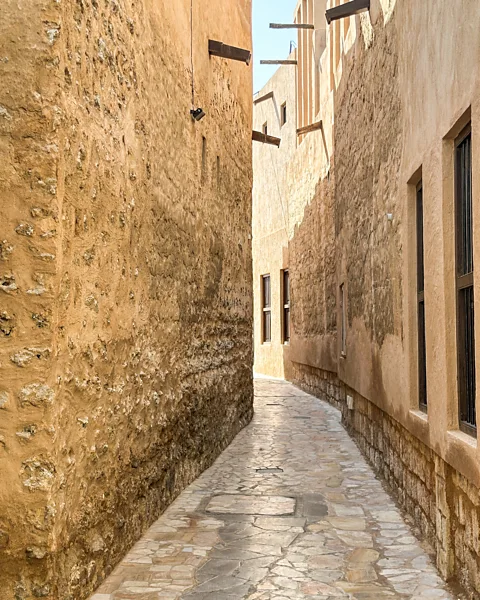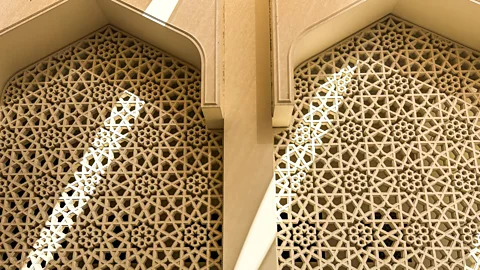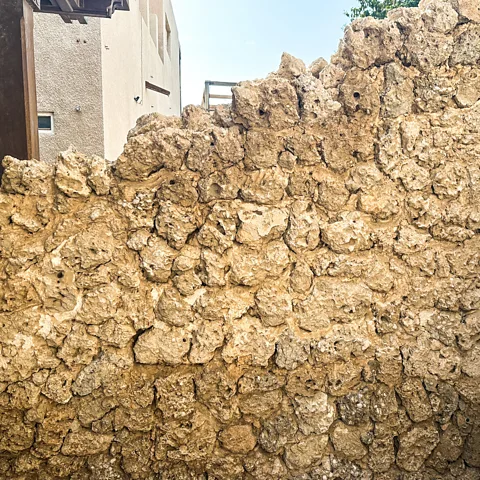How Old Dubai's historic streets beat extreme heat
 Soumya Gayatri
Soumya GayatriLong before our reliance on air-conditioning, Dubai's old town kept people's homes cool using a combination of clever techniques to lower the temperature. The same basic techniques are being revived again today.
There's no heat like the heat of a Dubai afternoon. It is relentless – and often reaches deadly temperatures. But there's a little-known part of the city where you can cool down, and do so the old-fashioned way, without air conditioning.
As I step out of the heat and into the narrow lanes of the Al Fahidi Historical Neighbourhood, part of Old Dubai, I find refuge from the midday Sun. The shaded alleys here, with their high walls, seem to conjure a cool breeze from nowhere. A kind of merciful magic. Desert winds cooled and somehow tamed. The people who built this place really knew what they were doing.
Above me, I see four storey-tall wind towers rising against the sky – ingenious structures that once cooled dwellings below. Today here in Dubai, they are home to pigeons. In this calm, more modest part of the city, luxury gives way to creativity and functionality. In the architecture of the streets, you can read the environmental wisdom of a people who worked out how to survive the desert.
Parts of the Al Fahidi Historical Neighbourhood date to the 1700s. But the passively cooled, heatwave-resistant designs of buildings here are only becoming more relevant today. They are inspiring contemporary architecture – and even entire cities. Urban planners are turning to places like Old Dubai for inspiration as they rush to respond to climate change and the threat of rising global temperatures.
And no wonder. If clever architecture can keep people in Dubai cool, could it help keep the rest of us cool too?
 Soumya Gayatri
Soumya GayatriLast year, temperatures in Dubai reached a scorching 51C and outdoor "feels like" temperatures – which take humidity into account – were as high as 62C. Air conditioning is widespread in the United Arab Emirates' (UAE), accounting for more than 70% of electricity consumption in the country during the summer months. However, proponents of traditional, passive cooling techniques say these tried and tested approaches to shading buildings and managing air flow could help people beat the heat without racking up massive electricity bills.
"The Emiratis built houses that were completely desert-proof," says Noor Ahmed, my tour guide. "Wind towers were used to catch the cool air from outside and drive out the hot air from inside," he adds. Gesturing at the labyrinthine alleyways of the old town, Ahmed points out how the high walls protect pedestrians from the blistering sun.
After Old Dubai emerged from the sands of time in the 1700s, it became a popular residential area when the ancestors of today's Emiratis transitioned from a nomadic to a more settled lifestyle along the Dubai Creek, a natural saltwater inlet that runs through the city.
The city's original inhabitants designed ingenious homes that could withstand the harsh climate of the Arabian Desert. They used technologies such as wind towers or wind-catchers known as barjeels, enclosed courtyards, latticed windows called mashrabiyas, coral stone houses, and narrow walkways called sikkas.
"The beauty of Al Fahidi's architecture lies in the fact that it uses several passive cooling techniques that work in tandem to keep the neighbourhood cool," says Ahmed Al-Jafflah, senior cultural speaker at Dubai's Sheikh Mohammed bin Rashid Al Maktoum Centre for Cultural Understanding, a nonprofit organisation that promotes Emirati culture and history. "Our ancestors built a holistic architectural system that optimised wind quality, enhanced shade and minimised exposure to the Sun – all of which were crucial to maintaining comfortable temperatures in Old Dubai," he adds.
 Soumya Gayatri
Soumya GayatriBarjeels, or traditional wind towers mounted on rooftops, create natural ventilation and cooling inside buildings by capturing breezes at a higher elevation and redirecting them inside. That cool air is then circulated inside the building while warm air rises and leaves. In some cases, this effect is enough to reduce internal temperatures by nearly 10C.
"Barjeels are one of the most effective approaches to cooling houses in the Gulf region," says Vrushali Mhatre, assistant professor in interior architecture and design at the Heriot-Watt University of Dubai. "That is why they have been widely adopted in modern buildings and complexes, including the modern Madinat Jumeirah and Khalifa Al Tjer Mosque, Dubai's Green Mosque that achieved Leed certification [a green building certification developed by the US Green Building Council] in 2016."
Most villas in the Al Fahidi Neighbourhood have inner courtyards that function as thermal regulators, allowing cool air to descend at night and spill into the surrounding rooms. Equipped with high walls, wide eaves and sometimes dense foliage, such courtyards provide protection from dust and sand and minimise Sun exposure. A study in Spain found that this form of architecture could lower a dwelling's cooling demands by up to 18%. Furthermore, the villa walls in the Al Fahidi Neighbourhood feature perforated window screens called mashrabiya that are used to control lighting. One 2024 study that simulated the effect these devices can have found that they could also reduce indoor temperatures by at least 3C.
"Old Dubai courtyards not only offer the comforts of natural light, cool air and shade but also provide a private, secure and tranquil inner space for the residents of the house, thus adhering to the local design principles of privacy and protection," adds Mhatre.
 Soumya Gayatri
Soumya GayatriWhile Emiratis once used light-coloured coral to reflect light and reduce heat absorption by buildings, the UAE now prohibits the extraction of coral, in order to protect marine life. Using lighter colours on building exteriors, however, remains one of the best ways to reduce temperatures inside buildings. Old Dubai buildings also sport features such as cladding and vegetation including tall palms, which help to shade buildings.
"Perhaps the most underrated, but equally essential, passive cooling mechanism at work in Al Fahidi is the sikka", says Al-Jafflah. Sikkas, a traditional Emirati architectural feature, are narrow pedestrian walkways, not broader than 2-3m (6.5-10ft), that run among villas and lead pedestrians to open public spaces. They allow unrestricted circulation of air, often yielding a pleasant breeze from the Dubai Creek. "Tourists love to sit and relax in the sikkas on our walking tours. They are so cool and peaceful," adds Al-Jafflah.
Architects in the UAE have used traditional design principles to create buildings that passively manage extreme heat. Take Masdar City, for example, a well-known urban community on the outskirts of Abu Dhabi that aims to be world-leading in sustainability. The district's urban layout, consisting of closely spaced buildings and narrow streets, maximises shade and harnesses prevailing winds for natural ventilation, lowering ambient temperatures by as much as 10C versus the surrounding environment. The buildings there incorporate passive cooling features, including wind towers and perforated facades, meaning they consume 40% less energy than conventional buildings in Abu Dhabi.
Officials say that such innovations have helped the city to cut its overall energy consumption by 38.4%.
"Masdar City has smartly revived old Emirati design elements that reduce reliance on mechanical cooling," says Sherihan Alshahed, assistant professor of sustainable urban communities at the Arab Academy for Science, Technology & Maritime Transport in Egypt. "Because these techniques are low-cost and low-tech, they are easy to replicate."
As a result, many modern structures in the UAE use traditional architectural designs inspired by the historic buildings of Old Dubai. Madinat Jumeirah, a luxurious complex of residential and commercial buildings in Dubai, has several wind towers and a maze of narrow lanes to improve wind circulation, thereby creating a cooler microclimate.
At Khalifa Al Tjer Mosque, one of the most recent additions to Dubai's skyline, small openings at the top and bottom of its pillars facilitate vertical air movement. "While not a full traditional barjeel, this design cleverly utilises [wind catching technology] in a contemporary scenario, which cools the space without relying entirely on artificial systems," says Mhatre.
Wind towers and their modifications are now a common sight all over the world. From the Royal Chelsea Hospital in London, UK, to Windcatcher House in Utah, USA.
Al Bahr Towers, a commercial complex, in Abu Dhabi are fitted with responsive mashrabiya screens that open and close depending on the position of the sun. This controls the amount of daylight entering the building and reduces glare. Louvre Abu Dhabi, an art museum, also features a mashrabiya-inspired domed ceiling.
Carbon Count
The emissions from travel it took to report this story were 0.16kg CO2, travelling by metro. The digital emissions from this story are an estimated 1.2g to 3.6g CO2 per page view. Find out more about how we calculated this figure here.
Contemporary buildings also make use of courtyard-style layouts, including the Sheikh Zayed Mosque in Abu Dhabi and the City Centre Midrif Shopping Mall in Dubai. They are not uncommon in other parts of the world, either. The Breathing Wall Residence in Thrissur, India, and the Optical Glass House in Hiroshima, Japan, are two examples of how indoor courtyards have been used for passive cooling in very different climatic conditions from those in the Gulf.
"These passive cooling techniques […] can be replicated around the world by customising them to the local climate," says Alshahed. "For example, in the tropics, rain and humidity have to be taken into account, whereas in the temperate regions, significant temperature variations and insulation need to be considered."
The common thread that connects the Old Dubai of the 1700s to modern, energy-efficient structures today is that crucial concept of designing buildings that are responsive to their environment. "Even today, understanding the ambient environment, and designing according to its needs, could contribute to cooling homes sustainably without the use of fossil fuels," says Mhatre.
--
For essential climate news and hopeful developments to your inbox, sign up to the Future Earth newsletter, while The Essential List delivers a handpicked selection of features and insights twice a week.
